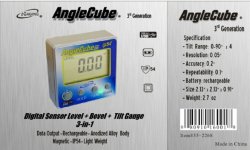smorgasbord
Member
I had shoulder surgery a few weeks ago, so I haven't been able to work wood, but I'm good enough now that I can still putz around in the shop. In mulling over my current project, a Murphy Bed (yes, taking forever), I've run into situations that have pushed me to getting a track saw (that's another thread), but also thinking about longish measurements - like 2 meters - that need to match (sides, front, etc.). Anyway, I'm able to lift a ruler, so I went about comparing my different measuring devices. I now work in metric where I can (hardware in the US dictates otherwise sometimes).
First up, I've got a selection of Shinwa metal rules. These are affordable and appear to be of good quality in terms of marking crispness, satin finish, and general machining. Here are some photos of how 3 different lengths (30cm, 60cm, 100cm) line up:
[attachimg=1]
At the 30cm mark:
[attachimg=2]
The shorter 30cm rule may be a hair short, or maybe I wasn't super accurate in lining them up, or maybe the end of the 30 wasn't ground just right. But in general, this is good enough I think (within 0.2mm)
I like hook rules for verifying lengths, but options are limited. I bought a Chinese one on Banggood a couple years ago, which doubles as a center finder. I was surprised how well it matched the Shinwas:
[attachimg=3]
I also have an old USA-made hook rule. This is a one-piece deal. I was surprised how off it was at 60cm:
[attachimg=4]
and even off at 20cm:
[attachimg=5]
Here's the zero end:
[attachimg=6]
So, there's definitely some kind of proportional to the length difference.
I also have a metric tape measure (Komelon brand). That didn't match up well, either:
[attachimg=7]
But, it turns out that because the hook has too much play. Here's the zero point, off by the same amount:
[attachimg=8]
And, if I manually align the Komelon and Shinwa at 1cm, they're very very close at 100cm.
So, what have I learned? Other than what I knew already: Accuracy is tough. I was happy that my different Shinwa rules matched each other pretty well (I'll have to double check that 30cm one though). I was surprised that my old USA rule was off so much and that my cheap Chinese rule was a pretty good match to the Shinwa, although 20cm is not a long enough distance to really know.
Banggood has a 90cm hook rule by the same company - I may try that since hook rules are hard to find. Hongdui also makes a T-square rule that is probably quite accurate (and pretty expensive), but I'm waiting for them to come out with a metric-only version.
Now, to be clear, I don't have any sort of trace-able, certified measurement devices. Comparing multiple rules against each other is not any sort of accuracy test - at best it's a tolerance/repeatability test. Then again, there was a time where the true meter was a block of metal in a climate-controlled basement in France. And after the French Revolution, 16 marble blocks were built and spread around Paris so workmen could check their work against something close to the standard. There's apparently still at least one you walk up to, and some in England too (https://www.atlasobscura.com/articles/what-happened-to-the-official-kilogram ).
Anyway, in my shop, the Shinwa 1 meter rule will be the standard and I'll test everything against that. Now that I think of it, I've got a Wixey DRO on my tablesaw so I should probably see if I calibrate that to cut to match the Shinwa at 100cm, then compare it at 20cm.
Now, I do have a a couple digital calipers - one an old Starrett (one of their first digital offerings), and one a new pretty cheap Chinese 200mm thing. The few things I measured with them matched within 0.01mm, IIRC. I suppose I could cut a wood block at some dimension within the 200mm caliper limit and see how the calipers compare to the Shinwas. I got the 200mm caliper to help calibrate my Shapeoko Pro CNC machine.
And here's where things get interesting. For years the term "aircraft aluminum" was bandied about, as if that was some kind of special alloy suitable not just for airplane bodies, but for tools. Which is crazy considering they need to survive in different environments and do different things. Now, we hear about "CNC accuracy," but what guarantee do we have that CNCs are truly accurate? I can believe they're "precise" (repeatable), but any sort of ball/lead screw may have machining variations, lash is a thing, and even stepper motors may not be exact in their partial revolution achievements. My consumer grade CNC has the ability in software to adjust the distance values, so my goal is to have the machine cut a 200mm square block and measure that with my digital caliper and adjust the software values until it's as close as I can get. I'll probably get a feel for how repeatable the CNC is while I'm at it.
Sorry to drag on, but one more: Angle measurements. I was watching a YouTuber review an adjustable track saw square, and he cut a 5º angle, then measured it with what was obviously a cheap digital protractor. That read 5.1º, which he decreed was good enough for the square, but all of the digital protractors I've seen available to mere mortals are +/- 0.2º at best (some +/-0.3º). Which is crazy bad. I built hexagonal newell toppers for my staircase at home. My first design had 12 pieces. A 0.2º error would mean that I'd have more than a 1º gap when gluing up - clearly unacceptable. I ended up gluing 6 pieces together for a base hexagon using my tablesaw sled, then using my CNC to inlay the contrasting wood. Turned out great, but I would have had a tough time doing that normally without a lot of hand trimming of pieces. Those gravity-based angle cubes are even worse on accuracy
I've toyed with the idea of getting a metal working bevel protractor to set my bevel and transfer that to my machinery, but the venier scales on those are marked at 5 minutes (1/12º), so maybe you can get twice that in repeatability, which still isn't good enough for some work, assuming you can maintain that value transferring to the bevel and then to the machine and then the machine cutting to its static setting.
Anyway, sorry for rambling - I'm obviously missing being in the shop. I start Physical Therapy in a couple days, so hopefully I'm back to cutting wood soon.
First up, I've got a selection of Shinwa metal rules. These are affordable and appear to be of good quality in terms of marking crispness, satin finish, and general machining. Here are some photos of how 3 different lengths (30cm, 60cm, 100cm) line up:
[attachimg=1]
At the 30cm mark:
[attachimg=2]
The shorter 30cm rule may be a hair short, or maybe I wasn't super accurate in lining them up, or maybe the end of the 30 wasn't ground just right. But in general, this is good enough I think (within 0.2mm)
I like hook rules for verifying lengths, but options are limited. I bought a Chinese one on Banggood a couple years ago, which doubles as a center finder. I was surprised how well it matched the Shinwas:
[attachimg=3]
I also have an old USA-made hook rule. This is a one-piece deal. I was surprised how off it was at 60cm:
[attachimg=4]
and even off at 20cm:
[attachimg=5]
Here's the zero end:
[attachimg=6]
So, there's definitely some kind of proportional to the length difference.
I also have a metric tape measure (Komelon brand). That didn't match up well, either:
[attachimg=7]
But, it turns out that because the hook has too much play. Here's the zero point, off by the same amount:
[attachimg=8]
And, if I manually align the Komelon and Shinwa at 1cm, they're very very close at 100cm.
So, what have I learned? Other than what I knew already: Accuracy is tough. I was happy that my different Shinwa rules matched each other pretty well (I'll have to double check that 30cm one though). I was surprised that my old USA rule was off so much and that my cheap Chinese rule was a pretty good match to the Shinwa, although 20cm is not a long enough distance to really know.
Banggood has a 90cm hook rule by the same company - I may try that since hook rules are hard to find. Hongdui also makes a T-square rule that is probably quite accurate (and pretty expensive), but I'm waiting for them to come out with a metric-only version.
Now, to be clear, I don't have any sort of trace-able, certified measurement devices. Comparing multiple rules against each other is not any sort of accuracy test - at best it's a tolerance/repeatability test. Then again, there was a time where the true meter was a block of metal in a climate-controlled basement in France. And after the French Revolution, 16 marble blocks were built and spread around Paris so workmen could check their work against something close to the standard. There's apparently still at least one you walk up to, and some in England too (https://www.atlasobscura.com/articles/what-happened-to-the-official-kilogram ).
Anyway, in my shop, the Shinwa 1 meter rule will be the standard and I'll test everything against that. Now that I think of it, I've got a Wixey DRO on my tablesaw so I should probably see if I calibrate that to cut to match the Shinwa at 100cm, then compare it at 20cm.
Now, I do have a a couple digital calipers - one an old Starrett (one of their first digital offerings), and one a new pretty cheap Chinese 200mm thing. The few things I measured with them matched within 0.01mm, IIRC. I suppose I could cut a wood block at some dimension within the 200mm caliper limit and see how the calipers compare to the Shinwas. I got the 200mm caliper to help calibrate my Shapeoko Pro CNC machine.
And here's where things get interesting. For years the term "aircraft aluminum" was bandied about, as if that was some kind of special alloy suitable not just for airplane bodies, but for tools. Which is crazy considering they need to survive in different environments and do different things. Now, we hear about "CNC accuracy," but what guarantee do we have that CNCs are truly accurate? I can believe they're "precise" (repeatable), but any sort of ball/lead screw may have machining variations, lash is a thing, and even stepper motors may not be exact in their partial revolution achievements. My consumer grade CNC has the ability in software to adjust the distance values, so my goal is to have the machine cut a 200mm square block and measure that with my digital caliper and adjust the software values until it's as close as I can get. I'll probably get a feel for how repeatable the CNC is while I'm at it.
Sorry to drag on, but one more: Angle measurements. I was watching a YouTuber review an adjustable track saw square, and he cut a 5º angle, then measured it with what was obviously a cheap digital protractor. That read 5.1º, which he decreed was good enough for the square, but all of the digital protractors I've seen available to mere mortals are +/- 0.2º at best (some +/-0.3º). Which is crazy bad. I built hexagonal newell toppers for my staircase at home. My first design had 12 pieces. A 0.2º error would mean that I'd have more than a 1º gap when gluing up - clearly unacceptable. I ended up gluing 6 pieces together for a base hexagon using my tablesaw sled, then using my CNC to inlay the contrasting wood. Turned out great, but I would have had a tough time doing that normally without a lot of hand trimming of pieces. Those gravity-based angle cubes are even worse on accuracy
I've toyed with the idea of getting a metal working bevel protractor to set my bevel and transfer that to my machinery, but the venier scales on those are marked at 5 minutes (1/12º), so maybe you can get twice that in repeatability, which still isn't good enough for some work, assuming you can maintain that value transferring to the bevel and then to the machine and then the machine cutting to its static setting.
Anyway, sorry for rambling - I'm obviously missing being in the shop. I start Physical Therapy in a couple days, so hopefully I'm back to cutting wood soon.
Attachments
-
 ThreeShinwaRules.jpg541.4 KB · Views: 166
ThreeShinwaRules.jpg541.4 KB · Views: 166 -
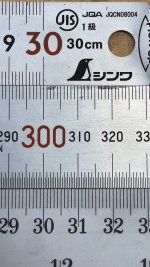 ThreeShinwaRulesCU.jpg921.8 KB · Views: 176
ThreeShinwaRulesCU.jpg921.8 KB · Views: 176 -
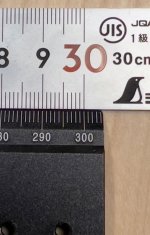 ShinwaBanggoodHook.jpg436.7 KB · Views: 162
ShinwaBanggoodHook.jpg436.7 KB · Views: 162 -
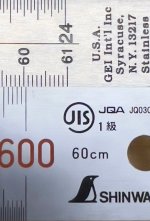 ShinwaUSAHookAt60cm.jpg453.2 KB · Views: 164
ShinwaUSAHookAt60cm.jpg453.2 KB · Views: 164 -
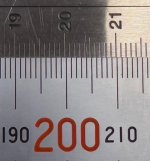 ShinwaUSAHookAt20cm.jpg496.7 KB · Views: 155
ShinwaUSAHookAt20cm.jpg496.7 KB · Views: 155 -
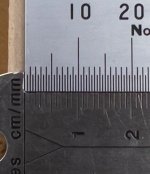 ShinwaUSAHookAt0cm.jpg442 KB · Views: 158
ShinwaUSAHookAt0cm.jpg442 KB · Views: 158 -
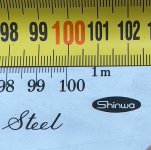 TapeShinaAt100cm.jpg812.9 KB · Views: 159
TapeShinaAt100cm.jpg812.9 KB · Views: 159 -
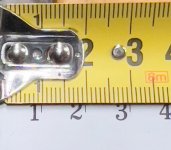 TapeShinaAt0cm.jpg485.8 KB · Views: 161
TapeShinaAt0cm.jpg485.8 KB · Views: 161

